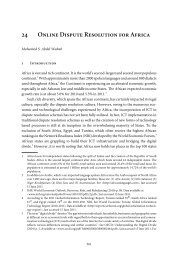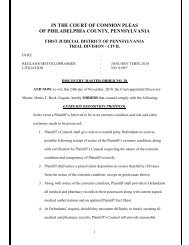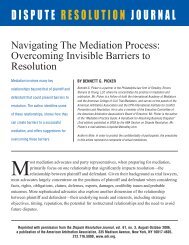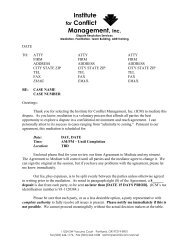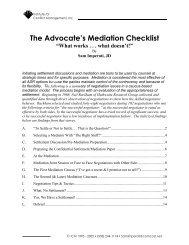17 e-Mediation - Mediate.com
17 e-Mediation - Mediate.com
17 e-Mediation - Mediate.com
You also want an ePaper? Increase the reach of your titles
YUMPU automatically turns print PDFs into web optimized ePapers that Google loves.
Noam Ebner<br />
another’s message. This not only makes the question more to the point and part of the<br />
flow of conversation, it also incorporates elements of active listening and reflecting. Instead<br />
of writing “When do you need the money paid?” we might write “In your last email you<br />
wrote ‘I am pressed for time and need the money ASAP’. I appreciate that you are in a real<br />
rush, however, I also heard your opposite say it will take her a little while to get money<br />
together, if indeed you both agree to payment being made. Can you tell me a bit more<br />
about our time frame?”<br />
Reframing: Katsh, Rifkin and Gaitenby 81 suggest that reframing is particularly tricky<br />
online: it can be done only after the narrative has already unfolded (parties have already<br />
sent out, and read, the accusatory or escalatory email) the mediator cannot jump in in the<br />
middle with a reframing word or sentence. This is reinforced by written word’s characteristic<br />
of being recorded and re-accessible; parties can read their opposites annoying email<br />
message, ruminate on it over time and enter consecutive, spiraling, anger cycles – all before<br />
forming a devastating reply of their own. 82 Parties might have ways to make their angry<br />
or toxic statements stand out and aggravate even more, for example by changing font size,<br />
writing with all caps or coloring a sentence in red. In asynchronous <strong>com</strong>munication,<br />
mediators need to be on the ball in order to interject reframing messages before things fly<br />
out of hand. Summers Raines 83 noted that shuttle diplomacy, in which all messages are<br />
sent to the mediator rather than being exchanged between parties with the mediator<br />
looking on, is particularly helpful for dealing with angry messages. Depending on their<br />
approach, mediators might reframe one party’s messages before moving them on to the<br />
other party, or discuss the message and its potential effects with the sender, reframing it<br />
together with them, before moving it on. 84<br />
Language issues are an immense challenge in online <strong>com</strong>munication, 85 and skills with<br />
written language are a must-have in an online mediator’s toolbox. 86 The lack of contextual<br />
cues such as body language and tone of voice leaves parties and mediators straining to<br />
infer meaning from any cue they can get 87 and in particular, attention returns to the actual<br />
wording of the text itself. This, as opposed to face-to-face <strong>com</strong>munication in which we<br />
infer most of a messages meaning from non-verbal cues. 88 With the written word spotlighted,<br />
shades of meaning, subjective interpretation and cultural differences turn every<br />
81 Katsh, Rifkin & Gaitenby (2000).<br />
82 See Nadler & Shestowsky (2006).<br />
83 Summers Raines (2006).<br />
84 Rule (2002).<br />
85 C. Rule and C. Villamore, “The Importance of Language in Online Dispute Resolution”, ICC International<br />
Court of Arbitration Bulletin, Special Supplement 2004.<br />
86 Rifkin (2001).<br />
87 Ebner (2007).<br />
88 A. Mehrabian, “Nonverbal Betrayal of Feeling”, J. of Experimental Research in Personality (1971) 5, 1, pp. 64-<br />
73.<br />
392



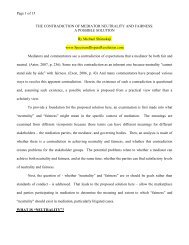

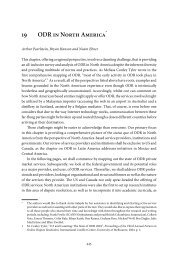
![Settlement Agreement Form [Agreement] - Mediate.com](https://img.yumpu.com/50682143/1/190x245/settlement-agreement-form-agreement-mediatecom.jpg?quality=85)

